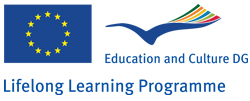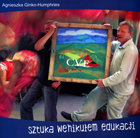|
PUBLICATION - ABOUT THE CVE BOOK

"This project has been funded with support from
the European Commission. This publication reflects the
views only of the author, and the Commission cannot be
held responsible for any use which may be made of the
information contained therein."

The paper-based publication "Cultural vehicles in education"
by Agnieszka Ginko-Humphries has been published as a textbook
on the new methodology, carefully designed and illustrated
(eg, photographs from all pilot workshops and creative
works made by the participants).
The main idea behind the book is both to present the
new methodology and to inspire the educators to use their
own
arts-based methods. The proposed scenarios of educational
units are written in such a way as to allow for easy
adaptation to the needs of one's group. Every exercise
can and should
be creatively developed and improved, often the workshop
participants introduce valuable changes, as it was discovered
during the CVE pilot workshops. The language of the book
is informal and user-friendly to go in line with the
CVE spirit. It is learner/reader centred, focused on
actively
involving the person in the educational matters, asking
surprising questions and encouraging creativity ("Perhaps
a story or poem will come to your mind?").
The edition of 3.000 copies in six languages (EN, FR, DE,
PL, LT, CS - 500 copies of each language) has ensured wide
distribution at the European level. The book has 147 pages,
with a cover in full-colour, and is spiral-bound to allow
for easy use at workshops and training sessions.
Review in English
Why do I like this book? First of all, the design and
appearance of the book reflect the true idea. The cover
is attractive. There are enough photographs and illustrations
making the book easy to page through and read. I must admit
that I read the book in one sitting. It is light and easy
to understand. The author presents the text in a dialogue
form, asking the reader questions. For example, the author
asks, "are you still reading"? Then, we are given time
to reflect, think, and feel our emotions. "Relax! Breathe
in and out. Perhaps a story or poem came to mind?" says
the author. The book presents its value through its instructional
structure. That is, the four countries where the project
took place are included and emphasized and genuine participant
comments and lecturer workplace interviews are presented.
In addition, the end of the book includes important aspects
of learning competencies which are currently being discussed
yet not everyone knows about them.
What is the significance of this book? First and foremost,
it is about creativity and practical application to learning
methods. Hanna Bloesser, an expert observer from Germany
talks about creativity and its meaning in an interview
saying that everyone is creative from birth. It is said
that early in childhood we teach our children to walk and
talk. Later we teach them to sit and be quiet. When they
grow up and learn about being creative, we invite them
to various creativity seminars where we teach them to experiment
and learn new ways and to be spontaneous.
Another important aspect of the book, according to expert
observer Arune Taunyte is the coordinated, successful effort
of gathering information, gathering the acquired skills
and the therapy of art itself. At one time art came into
the realm of therapy and took a firm hold. In this context
it is a means to the participants’ workplace motivational
learning, self knowledge, self respect, and trusting in
ones development.
Rasa Kučinskiene
Psychologist, andragogist,
Member of the Lithuanian Association of Adult Education,
member of the Psychodrama Society of Lithuania,
Board member of the Youth Psychological Aid Centre,
Editorial board member of the magazine "Psichologija Tau"
and co-worker of the magazine "Aą ir psichologija"
|